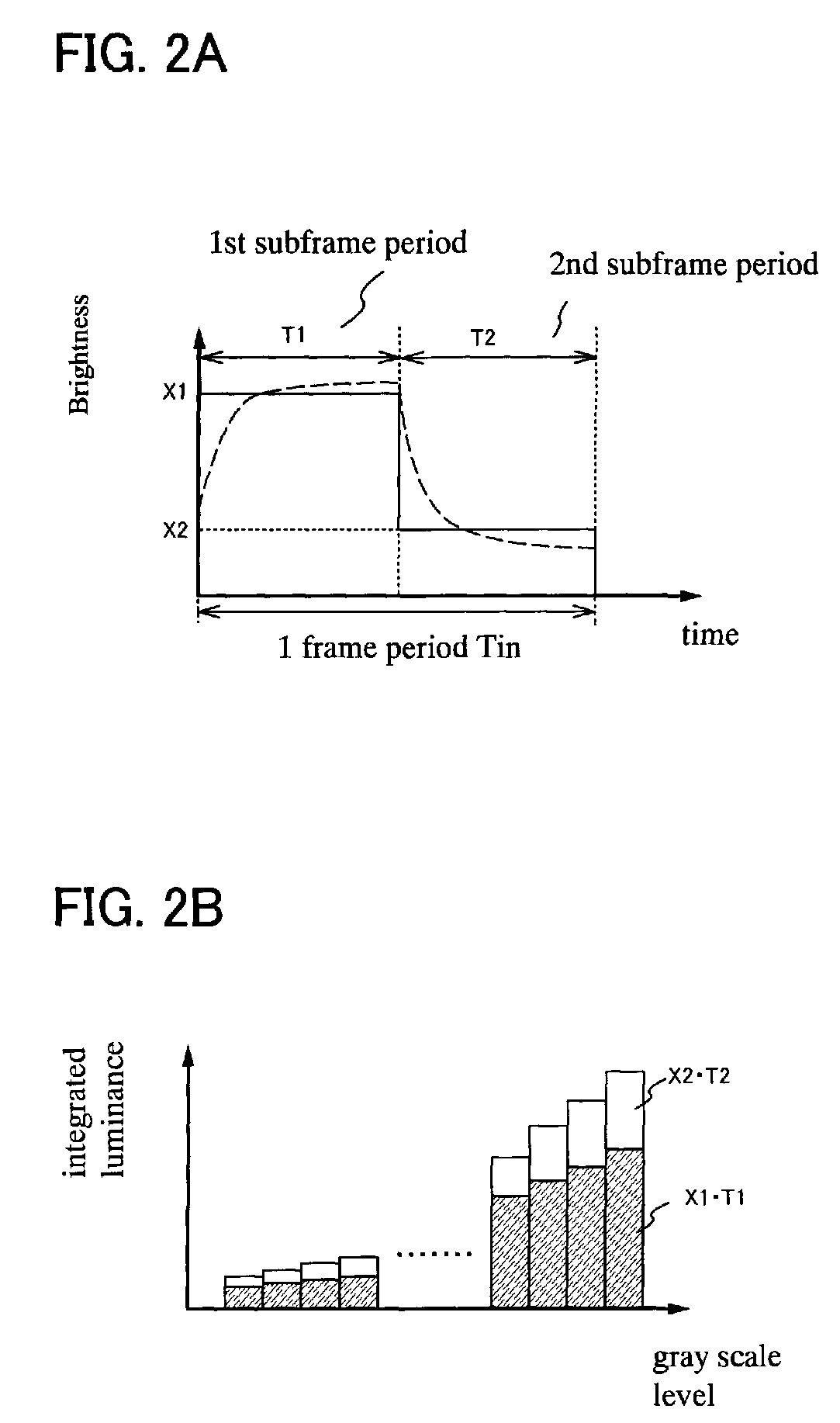Method for driving liquid crystal display device
a liquid crystal display device and driving method technology, applied in static indicating devices, instruments, non-linear optics, etc., can solve the problems of not having the quality of moving images equal, flickering increases, and insufficient effects, so as to improve image quality, reduce the amount of change, and widen the viewing angle
- Summary
- Abstract
- Description
- Claims
- Application Information
AI Technical Summary
Benefits of technology
Problems solved by technology
Method used
Image
Examples
embodiment mode 1
[0200]In this embodiment mode, an example of a method for improving quality of images displayed on a display device is described.
[0201]In this embodiment mode, a frame rate (the number of frames per second, unit: Hz, also referred to as input frame rate) of image data to be input does not necessarily correspond to a frame rate of display (also referred to as a display frame rate). When an input frame rate and a display frame rate are different from each other, the input frame rate can be converted by a circuit which converts a frame rate of image data (a frame rate conversion circuit) so that the input frame rate corresponds to the display frame rate. In such a manner, even when the input frame rate and the display frame rate are different from each other, display can be performed at a variety of display frame rates.
[0202]When the input frame rate is higher than the display frame rate, part of the image data to be input is discarded and the input frame rate is converted so that disp...
embodiment mode 2
[0518]In this embodiment mode, application examples of a method where image quality of a display device is improved, mainly change in driving method depending on circumstances are described. The circumstances here include contents of image data, environment inside and outside the device (e.g., temperature, humidity, barometric pressure, light, sound, electric field, the amount of radiation, altitude, acceleration, or movement speed), user settings, and software version.
[0519]A method in which movement of an image included in input image data is detected to form an intermediate image is described with reference to FIGS. 20A to 20E. FIGS. 20A to 20E schematically illustrate images displayed when the display frame rate is twice as high as the input frame rate. FIG. 20A schematically illustrates a method of detecting motion of the image with time represented by the horizontal axis. The period Tin represents a cycle of input image data. An image 2001 represents the p-th image. An image 2...
embodiment mode 3
[0581]In this embodiment mode, a method for improving quality of moving images by dividing one frame into two or more subframes and using some of the two or more subframes mainly for display images (a bright image) and the others mainly for reducing afterimages of moving images (a dark image) is described.
[0582]Difference between a black image and a dark image is described. The black image is an image where all of the pixels for forming an image are in a non-lighting state or a non-transmitting state, and is just an inky black image. On the other hand, the dark image is an image formed when most of the pixels for forming an image emit light with relatively low luminance. In other words, the dark image is an image where the total amount of light emission of all the pixels for forming an image is smaller than that of a corresponding bright image. In accordance with this definition, the black image is used as the dark image in some cases.
[0583]Next, integrated luminance is described. I...
PUM
| Property | Measurement | Unit |
|---|---|---|
| movement | aaaaa | aaaaa |
| brightness | aaaaa | aaaaa |
Abstract
Description
Claims
Application Information
 Login to View More
Login to View More - R&D
- Intellectual Property
- Life Sciences
- Materials
- Tech Scout
- Unparalleled Data Quality
- Higher Quality Content
- 60% Fewer Hallucinations
Browse by: Latest US Patents, China's latest patents, Technical Efficacy Thesaurus, Application Domain, Technology Topic, Popular Technical Reports.
© 2025 PatSnap. All rights reserved.Legal|Privacy policy|Modern Slavery Act Transparency Statement|Sitemap|About US| Contact US: help@patsnap.com



